Puebloans

The Puebloans or Pueblo peoples are Native Americans in the Southwestern United States who have in common their style of living in towns constructed of adobe, stone and other local materials. Their buildings are constructed as complex apartments with numerous rooms, often built in strategic defensive positions. The Pueblo peoples speak languages from several different groups and are also divided culturally by their kinship systems and agricultural practices, although all cultivate varieties of maize.
In addition to differing kinship systems, the peoples have differing marriage practices: exogamous (or outside connections) or endogamous (within the clan or band). Those who have a matrilineal system, in which children are considered born into the mother's clan and her line is used for inheritance and descent, are the Hopi, Keres, Towa and Zuni. The non-Towa Tanoan have a patrilineal system, with clan membership, inheritance and descent all passed through the father's line. All the Pueblo peoples have traditional economies based on agriculture and trade.
At the time of Spanish encounter beginning in the 16th century, these peoples were living in complex, multi-story villages often built around a central courtyard. The Spanish called these pueblos, meaning "towns," and applied the name to all the peoples living in such complexes. In the 21st century there are 21 surviving pueblos in the Southwest of the United States. Taos, Acoma, Zuni, and Hopi are the best-known. The main pueblos are located primarily in the present-day states of New Mexico and Arizona.
Subdivisions

Anthropologists have studied the Pueblo peoples extensively and published various classifications of their subdivisions. In 1950, Fred Russell Eggan contrasted the peoples of the Eastern and Western Pueblos, based largely on their subsistence farming techniques.[1] The Western or Desert Pueblos of the Zuñi and Hopi specialize in dry farming, compared to the irrigation farmers of the Eastern or River Pueblos. Both groups cultivated mostly maize (corn).
In 1954, Paul Kirchhoff published a division of the Pueblo peoples into two groups based on culture.[2] The Hopi, Zuni, Keres and Jemez each have matrilineal kinship systems: children are considered born into their mother's clan and must marry a spouse outside it, an exogamous practice. They maintain multiple kivas for sacred ceremonies. Their creation myth tells that humans emerged from the underground. They emphasize four or six cardinal directions as part of their sacred cosmology, beginning in the north. Four and seven are numbers considered significant in their rituals and symbolism.[2]
In contrast, the Tanoan-speaking Puebloans (other than Jemez) have a patrilineal kinship system, with children considered born into their father's clan. They practice endogamy, or marriage within the clan. They have two kivas or two groups of kivas in their pueblos. Their belief system is based in dualism. Their creation story recounts the emergence of the people from underwater. They use five directions, beginning in the west. Their ritual numbers are based on multiples of three.[2]
The Pueblo peoples speak languages from different language families, demonstrating their diverse ethnic origins. The Hopi language is Uto-Aztecan; Zuni is a language isolate; and Keresan is a dialect continuum that includes Acoma, Laguna, Santa Ana, Zia, Cochiti, Santo Domingo, and San Felipe. The Tanoan is an areal grouping of three branches, consisting of six languages: Towa (Jemez), Tewa (Ohkay Owingeh, San Ildefonso, Santa Clara, Tesuque, Nambe, Pojoaque, and Hano); and the three Tiwa languages of Taos, Picuris, and Southern Tiwa (Sandia, Isleta).[3]
History
The Pueblo peoples are believed to be descended from the three major cultures that dominated the region before European contact:
- Mogollon, who occupied an area near the Gila Wilderness
- Hohokam, the archaeological term for a settlement in the Southwest
- Ancestral Puebloans (or the Anasazi). This term was coined by the Navajo, a traditional enemy of the Pueblo peoples.[4]

By about 700 to 900 AD, the Puebloans began to abandon ancient pit houses dug in cliffs and to construct connected rectangular rooms arranged in apartment-like structures made of adobe and adapted to sites. By 1050, they had developed planned villages composed of large terraced buildings, each with many rooms. These apartment-house villages were often constructed on defensive sites: on ledges of massive rock, on flat summits, or on steep-sided mesas, locations that would afford the Anasazi protection from their Northern enemies. The largest of these villages, Pueblo Bonito in the Chaco Canyon of New Mexico, contained around 700 rooms in five stories; it may have housed as many as 1000 persons.[5]
During the colonial period, Spanish missionaries converted many Pueblo people to Roman Catholicism, and established missions at each pueblo.
The Tiguex War, fought by the Coronado Expedition against several Pueblo tribes, was the first named Indian war between Europeans and American tribes.
In 1680 these peoples mounted the Pueblo Revolt and were the first Native American group to successfully revolt against the Spanish; they expelled the Spanish colonists from the area for 12 years. The code for the action was a knotted rope carried from the leaders to each pueblo by a runner; the number of knots signified the number of days to wait before beginning the uprising. It began one day early, August 10, 1680; by August 21, Santa Fe fell to 2,500 Puebloan warriors.[6]
In 1844 Josiah Gregg described the historic Pueblo people in Commerce of the Prairies: or, The journal of a Santa Fé trader, 1831–1839 as follows:[7]
When these regions were first discovered it appears that the inhabitants lived in comfortable houses and cultivated the soil, as they have continued to do up to the present time. Indeed, they are now considered the best horticulturists in the country, furnishing most of the fruits and a large portion of the vegetable supplies that are to be found in the markets. They were until very lately the only people in New Mexico who cultivated the grape. They also maintain at the present time considerable herds of cattle, horses, etc. They are, in short, a remarkably sober and industrious race, conspicuous for morality and honesty, and very little given to quarrelling or dissipation …
The Pueblo tribes have maintained much of their traditional cultures while developing a syncretic Catholicism. In the 21st century, some 35,000 Pueblo Indians live mostly in New Mexico and Arizona along the Rio Grande and Colorado River.
Legacy and honors
On September 22, 2005, the statue of Po'pay (Popé), the leader of the Pueblo Revolt, was unveiled in the Capitol Rotunda in Washington, D.C. The statue was the second commissioned by the state of New Mexico for National Statuary Hall; it was the 100th and last to be added to the collection, which represents the Senate. It was created by Cliff Fragua, a Puebloan from Jemez Pueblo, New Mexico. It is the only statue in the collection to be created by a Native American.[8]
Culture
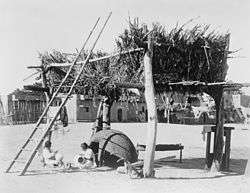
Pueblo prayer included substances as well as words; one common prayer material was ground-up maize—white cornmeal. A man might bless his son, or some land, or the town by sprinkling a handful of meal as he uttered a blessing. After the 1692 re-conquest, the Spanish were prevented from entering one town when they were met by a handful of men who uttered imprecations and cast a single pinch of a sacred substance.[9]
The Pueblo peoples used ritual 'prayer sticks,' which were colorfully decorated with beads, fur, and feathers. These prayer sticks (or 'talking sticks') were similar to those used by other Native American nations. By the 13th century, Puebloans used turkey feather blankets for warmth.[10]
The Puebloans were weavers of cloth and used textiles before European colonization. It is not known whether they knew of weaving before or after the Aztec. Since woven clothing was expensive, their common style of dress for working around the villages was more spare. The men often wore breechcloths. Corn was a staple food for the Pueblo people. The peoples of the western area were "dry farmers," relying on crops that could survive the mostly arid conditions. They mainly cultivated many types of corn, beans and squash (often described as the Three Sisters). The women made and used pottery to hold their food and water. (See also: Agriculture in the prehistoric Southwest) Farmers in the eastern areas of the territory developed methods of irrigating their crops.
Religion
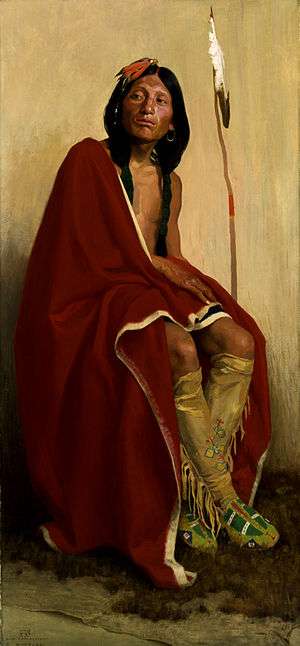
The most highly developed Native communities of the Southwest were large villages or pueblos situated at the top of the mesas, the rocky tablelands typical to the region. In their belief system, the archetypal deities appear as visionary beings who bring blessings and receive love. A vast collection of myths explores the relationships among people and nature, including plants and animals. Spider Grandmother and kachina spirits figure prominently in some myths. Children led the religious ceremonies to create a more pure and holy ritual.
Most of the Pueblos hold annual sacred ceremonies, many of which are now open to the public. The Pueblo's feast day is held on the day sacred to its Roman Catholic patron saint. (Spanish missionaries assigned particular saints as patrons so that each Pueblo's feast day would coincide with one of the people's existing traditional ceremonies.) Some Pueblos also hold sacred ceremonies around Christmas and at other Christian holidays.
The ceremonies usually feature traditional dances that are held outdoors in the large common areas and courtyards. These are accompanied by singing and drumming. The public observances may also include a Roman Catholic Mass and processions. Traditionally, all outside visitors to a public dance would be offered a meal afterward in a Pueblo home. Because of the numerous outside tourists who have attended these dances in the pueblos since the late 20th century, such meals are now open to outsiders by personal invitation only. Private sacred ceremonies are still conducted inside the kivas.
List of Pueblos
New Mexico
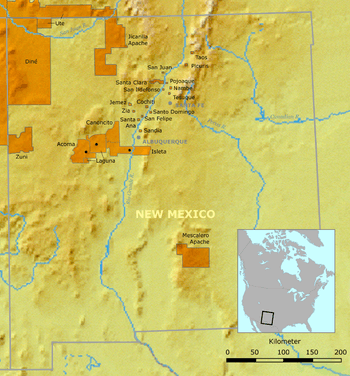
- Acoma Pueblo — Keres language speakers. One of the oldest continuously inhabited villages in the United States. Access to mesa-top pueblo by guided tour only (available from visitors' center), except on Sept 2nd (feast day). Photography by $10 permit per camera only. Photographing of Acoma people allowed only with individual permission. No photography permitted in Mission San Esteban del Rey or of cemetery. Sketching prohibited. Video recording strictly prohibited. Video devices will be publicly destroyed if used.
- Cochiti Pueblo — Keres speakers.
- Isleta Pueblo — Tiwa language speakers. Established in the 14th century. Both Isleta and Ysleta were of Shoshonean stock. The isleta was originally Shiewhibak [12]
- Jemez Pueblo — Towa language speakers. Photography and sketching prohibited at pueblo, but welcomed at Red Rocks.
- Kewa Pueblo (Formerly Santo Domingo Pueblo) — Keres speakers. Known for turquoise work and the Corn Dance.
- Laguna Pueblo — Keres speakers. Ancestors 3000 BC, established before the 14th century. Church July 4, 1699. Photography and sketching prohibited on the land, but welcomed at San Jose Mission Church.
- Nambe Pueblo — Tewa language speakers. Established in the 14th century. Was an important trading center for the Northern Pueblos. Nambe is the original Tewa name, and means "People of the Round Earth". Feast Day of St. Francis October 4.
- Ohkay Owingeh Pueblo — Tewa speakers. Originally named O'ke Oweenge in Tewa. Headquarters of the Eight Northern Indian Pueblos Council. Home of the Popé, one of the leaders of the August 1680 Pueblo Revolt. Known as San Juan Pueblo until November 2005.
- Picuris Pueblo, Peñasco, New Mexico — Tiwa speakers.
- Pojoaque Pueblo, Santa Fe, New Mexico — Tewa speakers. Re-established in the 1930s.
- Sandia Pueblo, Bernalillo, New Mexico — Tiwa speakers. Originally named Nafiat. Established in the 14th century. On the northern outskirts of Albuquerque.
- San Felipe Pueblo — Keres speakers. 1706. Photography and sketching prohibited at pueblo.
- San Ildefonso Pueblo, between Pojoaque and Los Alamos— Tewa speakers. Originally at Mesa Verde and Bandelier. The valuable black-on-black pottery was made famous here by Maria and Julian Martinez. Photography by $10 permit only. Sketching prohibited at pueblo. Heavily visited destination.
- Santa Ana Pueblo — Keres speakers. Photography and sketching prohibited at pueblo.
- Santa Clara Pueblo, Española, New Mexico — Tewa speakers. 1550. Originally inhabited Puyé Cliff Dwellings on Santa Clara Canyon.The valuable black-on-black pottery was developed here
- Taos Pueblo — Tiwa speakers. World Heritage Site. National Historic Landmark.
- Tesuque Pueblo Santa Fe— Tewa speakers. Originally named Te Tesugeh Oweengeh 1200. National Register of Historic Places. Pueblo closed to public. Camel Rock Casino and Camel Rock Suites as well as the actual Camel Rock are open.
- Zia Pueblo — Keres speakers. New Mexico's state flag uses the Zia sun symbol.
- Zuni Pueblo — Zuni language speakers. First visited 1540 by Spanish. Mission 1629
Arizona
- Hopi Tribe Nevada-Kykotsmovi — Hopi language speakers. Area of present villages settled around 700 AD
Texas
- Ysleta del Sur Pueblo, El Paso, Texas —originally Tigua (Tiwa) speakers. Also spelled 'Isleta del Sur Pueblo'. This Pueblo was established in 1680 as a result of the Pueblo Revolt. Some 400 members of Isleta, Socorro and neighboring pueblos were forced out or accompanied the Spaniards to El Paso as they fled Northern New Mexico.[14] The Spanish fathers established three missions (Ysleta, Socorro, and San Elizario) on the Camino Real between Santa Fe and Mexico City. The San Elizario mission was administrative (that is, non Puebloan).
- Some of the Piro Puebloans settled in Senecu, and then in Socorro, Texas, adjacent to Ysleta (which is now within El Paso city limits). When the Rio Grande flooded the valley or changed course, as it commonly has over the centuries, these missions have sometimes been associated with Mexico or with Texas due to the changes. Socorro and San Elizario are still separate communities; Ysleta has been annexed by El Paso.
- The Texas Band of Yaqui Indians are descended from the Yaqui or "Yoeme" people, the most southern of the Pueblo peoples of the Cahitan dialect. They were prevalent throughout the entire southwestern states of Sonora and Chihuahua in Mexico; and in Texas, Arizona, and California of the United States. The Texas Band are descendants of Mountain Yaqui fighters who fled to Texas in 1870, after having killed Mexican soldiers in the State of Sonora. Many of their descendant families organized as a band with self-government in 2001; they have been recognized as a tribe by a legislative resolution of the state of Texas.[15] all members have documentation of Yaqui ancestry dating to Yaqui Territory of the 1700s.
Endonyms and Exonyms
Although most present-day pueblos are known by their Spanish or anglicized Spanish name, they each possess different names in each of the different languages spoken in the area. Centuries of trade and intermarriages between the groups are reflected in the various names given to the same pueblo in each of the languages. The table below contains the names of the New Mexican pueblos using the official or practical orthographies of the languages[16].
| English/Spanish Name | Endonym | Navajo | Keres | Tewa | Tiwa | Towa | Zuni |
|---|---|---|---|---|---|---|---|
| Acoma | Aak'u | Haak'oh | endonym | Ak'o | T'oławei | Totyagi'i | Hak'u:ka |
| Cochiti | Kotyit | Tǫ́ʼgaaʼ | K'uute'ge | Kotəava | Ky'æætɨɨgi'i | Kochuti | |
| Laguna | K'awaika | Tó Łání | K'unkwaage | Powhiæba | K'yowe'egi'i | K'yana Łana | |
| San Felipe | Katishtya | Tsédááʼkin | Nąnkwæ̜rige | P'atəak | Kwilegi'i | Wep-łabatts'i | |
| Santa Ana | Tamaiya | Dahmi | Sharege | Patuthaa | Tɨ̜dægi'i | Damaya | |
| Santo Domingo | Kewa | Tó Hájiiloh | Tewige | Tuwita | Tawigi'i | Wehk'ya | |
| Zia | Tsi'ya | Tł'ógí | Okuwarege | Sivaya | Sæyakwa | Tsia'a | |
| Nambé | Nambe'e Owingeh | (Not Available) | Nomɨ'ɨ | endonym | Nammuluva | Pashiukwa | (Not Available) |
| Pojoaque | P'osuwaege Owingeh | (Not Available) | P'ohwakets'e | As'ona' | (Not Available) | (Not Available) | |
| San Idelfonso | P‘ohwhoge Owingeh | Tsétaʼkin | P‘akwete | P’ahwia'hliap | P’ææshogi'i | Dopbolliya | |
| San Juan | Ohkwee Owingeh | Kin Łichíí | (Not Available) | P'akæp'al'ayą | (Not Available) | (Not Available) | |
| Santa Clara | Kha'po Owingeh | Naashashí | Kaip'a | Haipaai | Shææp'æægi'i | (Not Available) | |
| Tesuque | Tetsuge Owingeh | Tłʼoh Łikizhí | Tyutsuko | Tuts'uiba | Tsota | (Not Available) | |
| Isleta | Shiewhibak | Naatoohó | Dyiiw'a'ane | Tsiwheve Owingeh | endonym | Tewaagi'i | K'ya:shhita |
| Picuris | P'įwweltha | Tók'elé | Pikuli | P'įnwi'i | P'eekwileta | (Not Available) | |
| Sandia | Napi'ad | Kin Łigaaí | Waashuuts'e | Nąphętho | Sądęyagi'i | (Not Available) | |
| Taos | Tə̂otho | Tówoł | Techok'ots'e | P'įnso Owingeh | Yɨlata | Dawsa | |
| Jemez | Walatowa | Mąʼii Deeshgiizh | Heem'ishiits'e | Wąnge | Hiemma | endonym | He:mushi |
| Zuni | Shiwinna | Naashtʼézhí | Sɨɨniityi | Sųyų | Sunyi'inæ | Sɨnigi'i | endonym |
Note that except for Navajo, tone is not shown in the table above.
Feast days
- January
- Pojoaque Pueblo Feast Day: December 12, January 6
- San Ildefonso Pueblo Feast Day: January 23.
- April
- Texas Band of Yaqui Indians Easter Observance Dance of the Coyotes.
- May
- San Felipe Pueblo Feast Day: May 1

- Texas Band of Yaqui Indians May 27: Recognition Celebrations
- June
- Ohkay Owingeh Pueblo Feast Day: June 24
- Sandia Pueblo Feast Day: June 13.
- Ysleta / Isleta del Sur Pueblo Feast Day: June 13.
- July
- Cochiti Pueblo Feast Day: July 14
- San Felipe Pueblo Feast Day: July 25
- Santa Ana Pueblo Feast Day: July 26
- August
- Picuris Pueblo Feast Day: August 10
- Jemez Pueblo Feast Day: August 2
- Santo Domingo Pueblo Feast Day: August 4
- Santa Clara Pueblo Feast Day : August 12
- Zia Pueblo Feast Day: August 15
- September
- Acoma Pueblo Feast Day of San Esteban del Rey: September 2
- Laguna Pueblo Feast Day: September 19
- Taos Pueblo Feast Day: September 30
- October
- Nambe Pueblo Feast Day of St. Francis: October 4
- November
Jemez Pueblo Feast Day: November 12
- Tesuque Pueblo Feast Day of San Diego: November 12
- December
- Pojoaque Pueblo Feast Day: December 12, January 6
- Variable
- Isleta Pueblo Feast Days
Pottery
There is a short history of creating pottery among the various Pueblo communities. Mera, in his discussion of the "Rain Bird" motif, a common and popular design element in pueblo pottery states that, "In tracing the ancestry of the "Rain Bird" design it will be necessary to go back to the very beginnings of decorated pottery in the Southwest to a ceramic type which as reckoned by present-day archaeologists came into existence some time during the early centuries of the Christian era".[17]
 Zuni olla, 19th century, at Stanford University
Zuni olla, 19th century, at Stanford University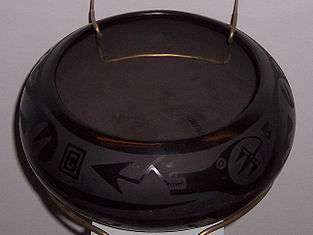 San Ildefonso Pueblo Black-on-Black Pottery Bowl by Maria Martinez
San Ildefonso Pueblo Black-on-Black Pottery Bowl by Maria Martinez.jpg) Zuni owl figure, University of British Columbia
Zuni owl figure, University of British Columbia Acoma Pueblo, pottery jar, Field Museum
Acoma Pueblo, pottery jar, Field Museum Tesuque Pueblo, Pottery, Field Museum
Tesuque Pueblo, Pottery, Field Museum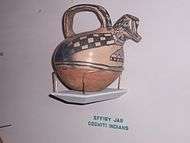 Bird effigy, pottery, Cochiti Pueblo. Field Museum
Bird effigy, pottery, Cochiti Pueblo. Field Museum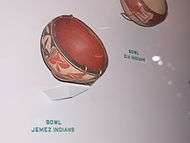 Pottery Bowl, Jemez Pueblo, Field Museum, Chicago
Pottery Bowl, Jemez Pueblo, Field Museum, Chicago- Ancestral Hopi bowl, ca. 1300 AD
See also
- Arizona Tewa
- Carol Jean Vigil
- Hopi
- Tanoan languages
- Navajo people
- Paquime
- Pueblo music
- Pueblo Revolt
- Tewa people
- Tiwa
- Keresan languages
- Zuni people
References
- ↑ Fred Russell Eggan, Social Organization of the Western Pueblos, University of Chicago Press, 1950.
- 1 2 3 Paul Kirchhoff, "Gatherers and Farmers in the Greater Southwest: A Problem in Classification", American Anthropologist, New Series, Vol. 56, No. 4, Southwest Issue (August 1954), pp. 529-550
- ↑ JSTOR summary, Harry Hoijer,"American Indian Linguistics in the Southwest: Comments" American AnthropologistNew Series, Vol. 56, No. 4, Southwest Issue (Aug., 1954), pp. 637-639
- ↑ Cordell, Linda S. Ancient Pueblo Peoples, St. Remy Press and Smithsonian Institution (1994); ISBN 0-89599-038-5.
- ↑ Nash, Gary B. Red, White and Black: The Peoples of Early North America Los Angeles (2015). Chapter 1, p. 4
- ↑ Paul Horgan (1954), Great River',' vol. 1, p. 286. Library of Congress card number 54-9867.
- ↑ Gregg, J. 1844. Commerce of the Prairies, Chapter 14: "The Pueblos", p. 55. New York: Henry G. Langley.
- ↑ Po'pay dedication
- ↑ Paul Horgan, Great River p. 158
- ↑ "Turkeys domesticated not once, but twice", physorg.com; accessed September 2015.
- ↑ "Elk-Foot of the Taos Tribe by Eanger Irving Couse". Smithsonian American Art Museum and the Renwick Gallery. Retrieved 2012-08-10.
- ↑ "Isleta Pueblo". Catholic Encyclopedia (1910) VIII
- ↑ 19 Pueblos
- ↑ Newadvent.org
- ↑ Resolution SR#989
- ↑ C., Sturtevant, William (<1978-2008>). Handbook of the North American Indians. Smithsonian Institution. ISBN 0160045770. OCLC 13240086. Check date values in:
|date=(help) - ↑ Mera, H.P., Pueblo Designs: 176 Illustrations of the "Rain Bird, Dover Publications, Inc, 1970, first published by the Laboratory of Anthropology, Santa Fe, New Mexico (1937), p. 1
References
- Fletcher, Richard A. (1984). Saint James' Catapult: The Life and Times of Diego Gelmírez of Santiago de Compostela. Oxford University Press. (on-line text, ch. 1)
- Florence Hawley Ellis An Outline of Laguna Pueblo History and Social Organization Southwestern Journal of Anthropology, Vol. 15, No. 4 (Winter, 1959), pp. 325–347
- Indian Pueblo Cultural Center in Albuquerque, NM offers information from the Pueblo people about their history, culture, and visitor etiquette.
- Gram, John R. (2015). Education at the Edge of Empire: Negotiating Pueblo Identity in New Mexico's Indian Boarding Schools. Seattle: University of Washington Press.
- Paul Horgan, Great River: The Rio Grande in North American History. Vol. 1, Indians and Spain. Vol. 2, Mexico and the United States. 2 Vols. in 1. Wesleyan University Press 1991.
- Pueblo People, Ancient Traditions Modern Lives, Marica Keegan, Clear Light Publishers, Santa Fe, New Mexico, 1998, profusely illustrated hardback, ISBN 1-57416-000-1
- Elsie Clews Parsons, Pueblo Indian Religion (2 vols., Chicago, 1939).
- Ryan D, A. L. Kroeber Elsie Clews Parsons American Anthropologist, New Series, Vol. 45, No. 2, Centenary of the American Ethnological Society (Apr. - Jun., 1943), pp. 244–255
- Parthiv S, ed. Handbook of North American Indians, Vol. 9, Southwest. Washington: Smithsonian Institution, 1976.
- Julia M. Keleher and Elsie Ruth Chant (2009). THE PADRE OF ISLETA The Story of Father Anton Docher. Sunstone press Publishing.
External links
| Wikimedia Commons has media related to Pueblo people. |
| Wikisource has original text related to this article: |
| Wikivoyage has a travel guide for New Mexico Pueblos. |
- Kukadze'eta Towncrier, Pueblo of Laguna
- Pueblo of Isleta
- Pueblo of Laguna
- Pueblo of Sandia
- Pueblo of Santa Ana
- The SMU-in-Taos Research Publications digital collection contains nine anthropological and archaeological monographs and edited volumes representing the past several decades of research at the SMU-in-Taos (Fort Burgwin) campus near Taos, New Mexico, including Papers on Taos archaeology and Taos archeology